Frances Xavier Cabrini (1850-1917) has been in the news recently. The Catholic saint, born in Lodi on the Italian peninsula (then a part of the Austrian empire) became a nun at age 27 after the deaths of her parents. Born Francesca Saverio Cabrini, she added “Xavier” to her name to honor patron saint Francis Xavier. Interested in founding missionaries, she helped found the Institute of the Missionary Sisters of the Sacred Heart of Jesus in 1880, and she traveled to the USA in 1889 and organized catechism and schooling for Italian immigrants, using great powers of persuasion to accrue donations, eventually founding Italian Hospital, later the Cabrini Medical Center, which remained open until 2008.
The tireless Cabrini founded over 60 schools and orphanages throughout the United States, South America and Europe. She became a United States citizen in 1909, eight years before her death. She was beatified in 1938 (the first step in becoming a saint) and finally canonized in 1946. She was the first naturalized US citizen to become a saint; Elizabeth Bayley Seaton was the first native-born US citizen to do so. There are three shrines to her honor in the USA, in Chicago; Golden, Colorado; and Washington Heights, New York, several miles south of her original burial plot in West Park in Ulster County.
When Chirlane McCray, Mayor Bill DeBlasio’s wife, founded the initiative “She Built NYC,” part of it was a nonbinding public vote for the initial stature proposals; while Cabrini came in first, an outroar erupted when McCray announced that Cabrini would not be among the first batch of sculptures to appear. On Columbus Day 2019, Governor Andrew Cuomo announced that the state would fund a Cabrini statue, prompting DeBlasio to accuse him of politicizing the affair. It’s an ongoing story as this is written.
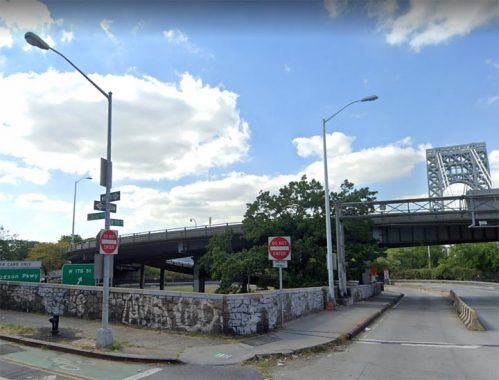
There’s been a Cabrini Boulevard in Washington Heights, about a block east of the Hudson River, since 1938. When streets were laid out in the region in the first decade of the 20th Century, the street now called Cabrini Boulevard (running a block from West 177th to 178th, near the spaghetti onramps for the George Washington Bridge, and for several blocks from West 179th north along a ridge overlooking the river to Fort Washington Avenue at Fort Tryon Park, was called, somewhat prosaically, Northern Avenue. The street was renamed Cabrini Boulevard upon the future saint’s beatification.
It also became one of Manhattan’s only “Boulevards”; while “boulevards” turn up frequently in the other four boroughs, they were unknown in the Original Borough. 7th and 8th Avenues were renamed Adam Clayton Powell Boulevard and Frederick Douglass Boulevard in the 1970s.
Pictured above is Cabrini Boulevard and West 178th, and the rather obscure ramp bicyclists use to access the George Washington Bridge.
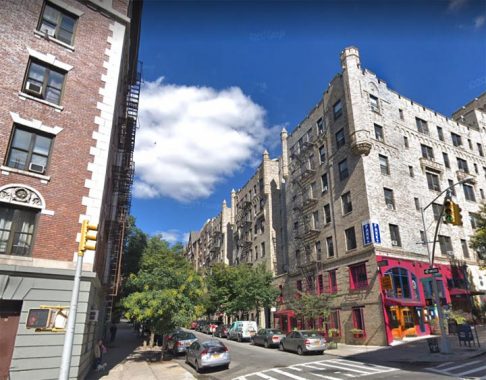
While much of Manhattan features walkup apartment buildings, northern Manhattan and the Bronx are marked by fortress-like apartment houses, such as these, on the corner of Cabrini Boulevard and West 181st Street.
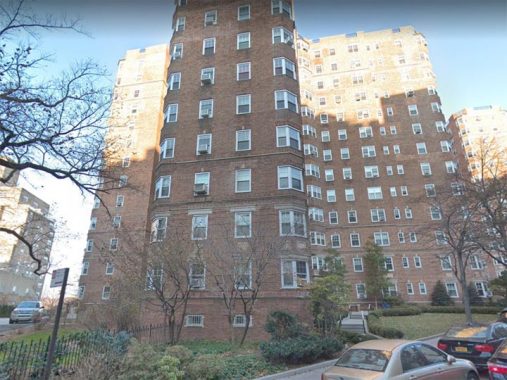
The upper west side of Manhattan, and indeed, many of the choice waterfront areas of New York City, from the mid-1800s on, featured large, fortress-like mansions by the bright lights of that time. Paterno Castle, in its time, rivaled the Xanadu that Bill Gates designed for himself in Washington State.
Paterno Castle stood at what is now Cabrini Boulevard and West 181st Street in Washington Heights. Italian immigrant Dr. Charles Paterno (1877-1946; no relation, as far as I know, to deceased Penn State coach Joe Paterno) built it between 1907 and 1909. It contained a mushroom cellar, a swimming pool surrounded by birdcages, and a 20′ by 80′ master bedroom. Its seven-acre site was surrounded by woods and greenhouses.
Charles Paterno and brother Joseph built many of the grand apartment buildings in the area, and by 1918 he owned 75 buildings housing about 28,000 people. In that year he built 270 Park Avenue, which takes up the entire Park-Madison-47th-48th Street block, which stood until 1960. By 1938, Paterno had demolished Paterno Castle and built Castle Village, shown here, five thirteen-story towers containing 580 apartments. But the old Castle’s retaining wall can still be seen along Henry Hudson Parkway.
Paterno’s Castle [My Inwood]

“Trivium” is a compound Latin word meaning “three roads.” Cabrini Boulevard, Pinehurst Avenue, and West 187th Street meet here, opposite Castle Village at what the Parks Department has named Paterno Trivium.

Northern Avenue’s renaming as Cabrini Boulevard is hardly arbitrary. Frances X. Cabrini has been associated with Washington Heights since 1890, when she purchased a parcel of property above West 190th Street; a school was established there soon after. In 1933, her remains were moved from her burial place in West Park to the chapel of Cabrini High School as part of the process of making this a national shrine to the saint’s memory. A new Shrine was constructed in 1957, and her remains can be seen in a glass case beneath the chapel altar: a wax replica of her body contains the saint’s bones.
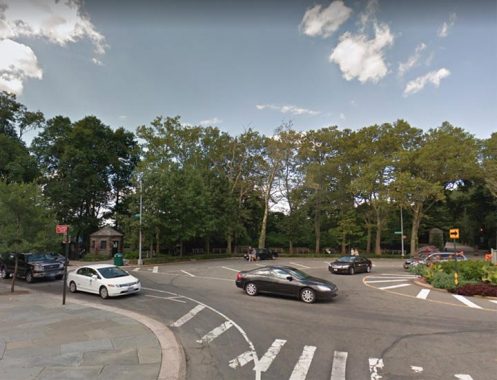
Curving around the ridge above the Hudson River, Cabrini Boulevard ends at Fort Washington Avenue and the southern entrance to Fort Tryon Park. Though NYC divested itself of most of its colonial-era “royal” names after defeating the British in the Revolutionary War, there are a few that doggedly hang on, such as Prince Street in Soho, Kings Highway in Brooklyn, and Fort Tryon Park in upper Manhattan, which was named for British fort commemorating Sir William Tryon (1729-1788) , the last British governor of the colonies before the scurvy rebels kicked them out. The city took title to the property, which was in part owned by the former Cornelius Billings estate, in 1917, and the large (67 acres) park was designed by Frederick Law Olmsted Jr. (son of the Central and Prospect Park developer) in 1935. It’s the home of The Cloisters, a branch of the Metropolitan Museum of Art specializing in medieval art and assembled by John D. Rockefeller Junior in 1938.
Check out the ForgottenBook, take a look at the gift shop, and as always, “comment…as you see fit.”
10/16/19

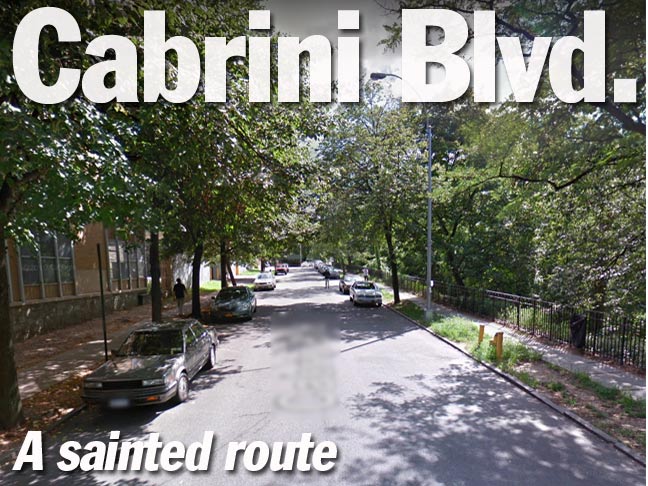
13 comments
Of all the Tory names to keep William Tryon was an especially despised one for his strategy of attacking civilians in the revolution. Even his own commanders hated him. There’s a great pub on Broadway called Tryon’s.
It’s amazing that it was never renamed considering he had two counties that were named after him renamed after the war…then again, he had a lot of support in the city so what other places felt about him didn’t matter.
Always enjoy reading, and learning from your posts. You write beautifully! …
Filmed nearby: Clint Eastwood worked there –
https://www.bing.com/search?q=%22Coogan%27s+Bluff%22+trailer&form=PRUSEN&mkt=en-us&httpsmsn=1&refig=7e1d569395a5428086ab36ad87138229&sp=-1&pq=%22coogan%27s+bluff%22+trailer&sc=1-24&qs=n&sk=&cvid=7e1d569395a5428086ab36ad87138229
Sorry about that. Here’s a much better trailer:
https://www.movie-trailer.co.uk/trailers/1968/coogans-bluff/#play
This comment is left to inform you of another shrine in honor of Mother Cabrini. It is located in Peru, New York and managed by St. Augustine’s Parish in the same town. -Denise Coughlin
I’m disappointed you didn’t comment on:
The odd GWB Playground at 180th St & Cabrini (gate seldom unlocked), Plaza Lafayette (median park) at 181st between Cabrini & Riverside Dr, the private walkway through Hudson View Gardens for Castle Village (unnamed in your photo), the village-like commercial district at 187th St between Cabrini & Ft Washington and great bird watching of open west side of the street (in your title card.
It’s a wonderful street for a walk between 181st & Corbin Circle (& into Ft Tron Park).
Just wanted to concentrate on Cabrini Boulevard. I plan a more thorough survey of the Fort Tryon Park area when I get the chance.
Boulevards aren’t really that frequent in Brooklyn sincevthere are only about 10 or 11 of them and a couple of them were formerly avenues such as Mother Gaston Blvd which was formerly Stone Ave, Manhattan had two numbered avenues uptown reclassified as boulevards Adam Clayton Powell Jr Blvd takes place of 7 Ave while Frederick Douglas Blvd is in place of 8 Ave
Re: Boulevards in NYC, Queens has to be the leader. There must be dozens. One day, I’ll try to remember as many as I can from memory. Using a Map Index would be cheating. Please don’t do that and post the number here. SPOILERS are not fair!
Paterno Trivium is not opposite Castle Village. Castle Village is a block south.
I once heard Cabrini used to run south not north as it does now. As I heard the story, a cop high up in the department lived on Cabrini and got the traffic flow switched because many were concerned about people going down the street too fast.
I grew up on Cabrini and 187th Street. On my first “car date”, the youngman drove down Cabrini Blvd the wrong way lol